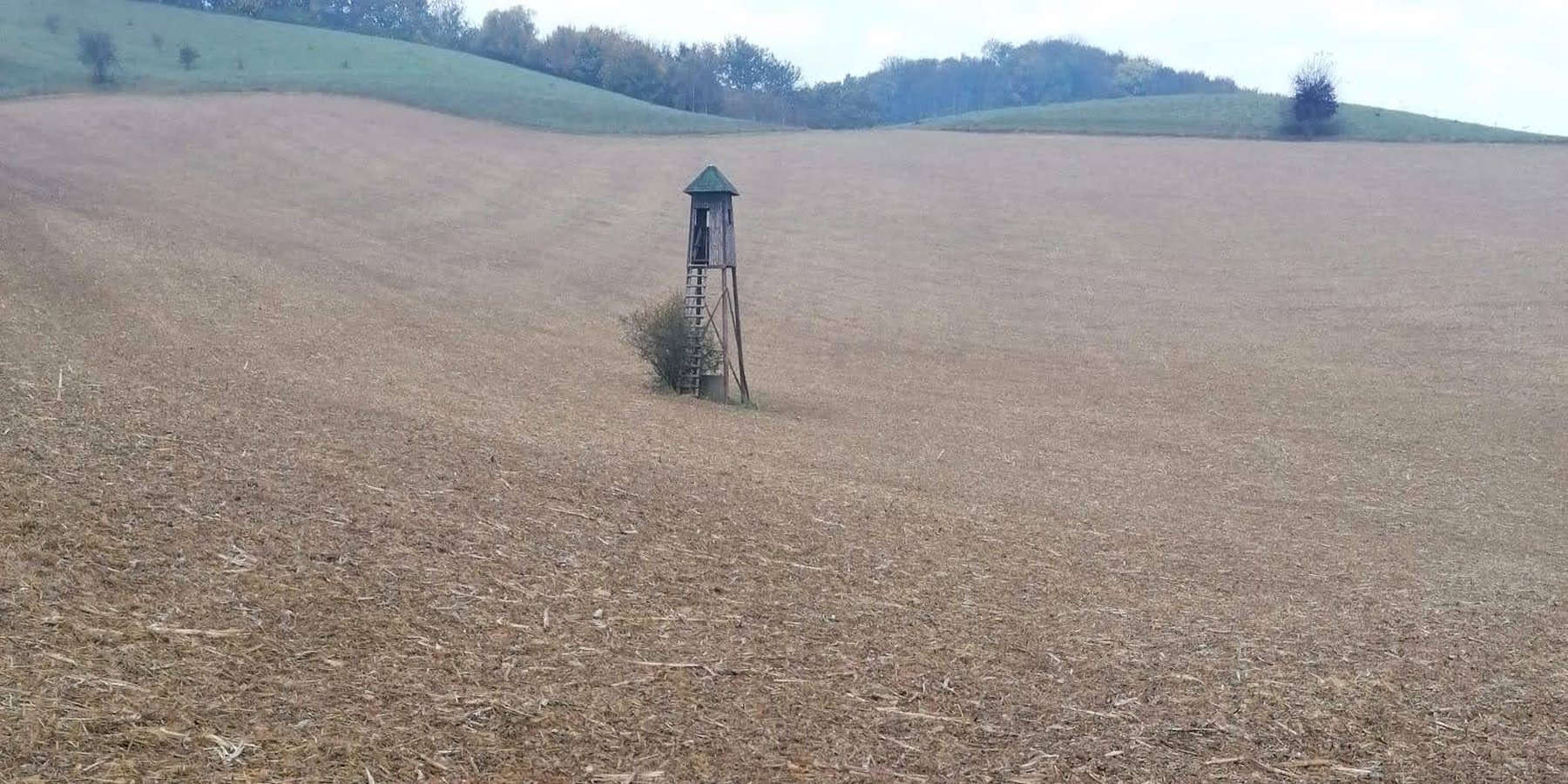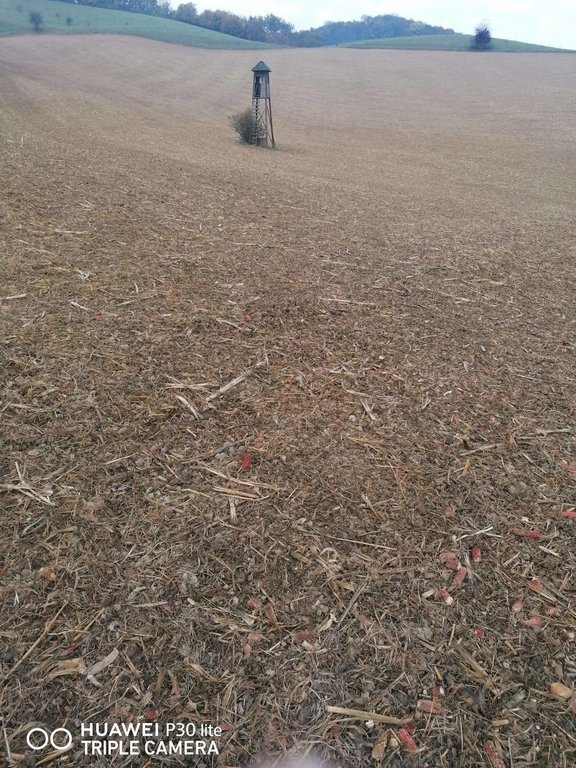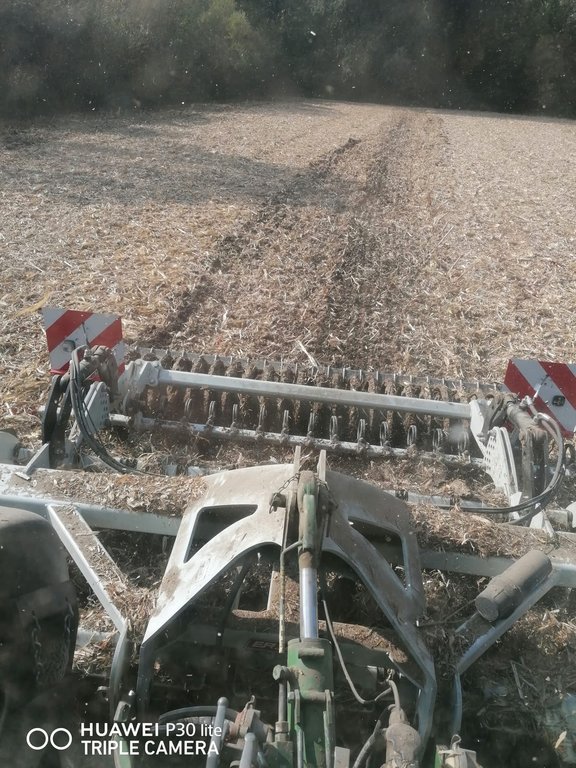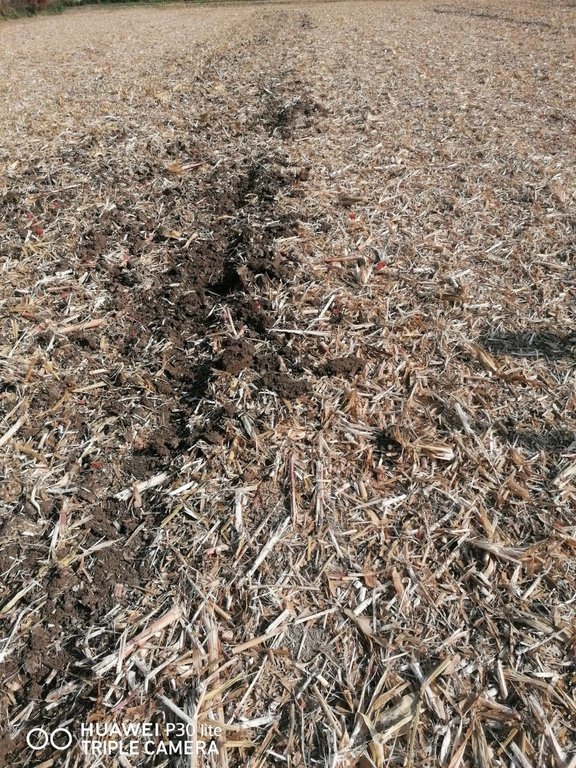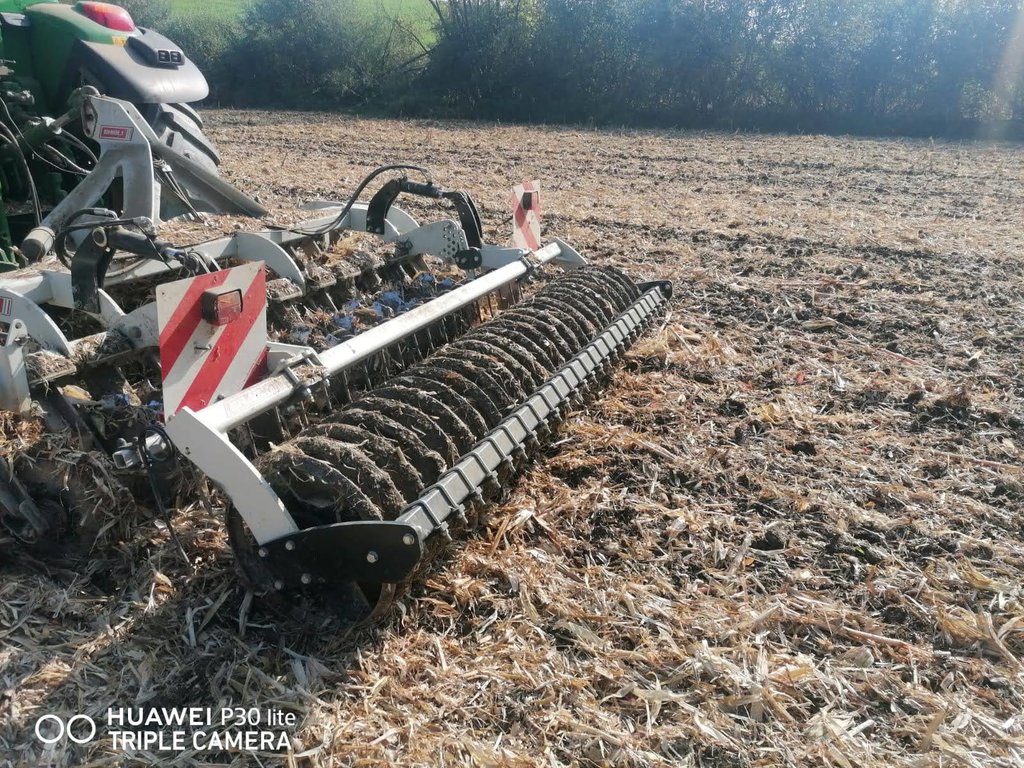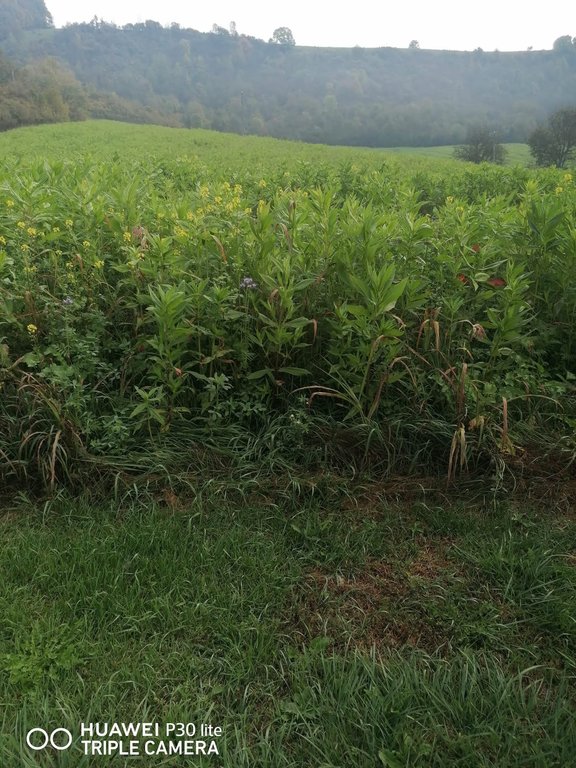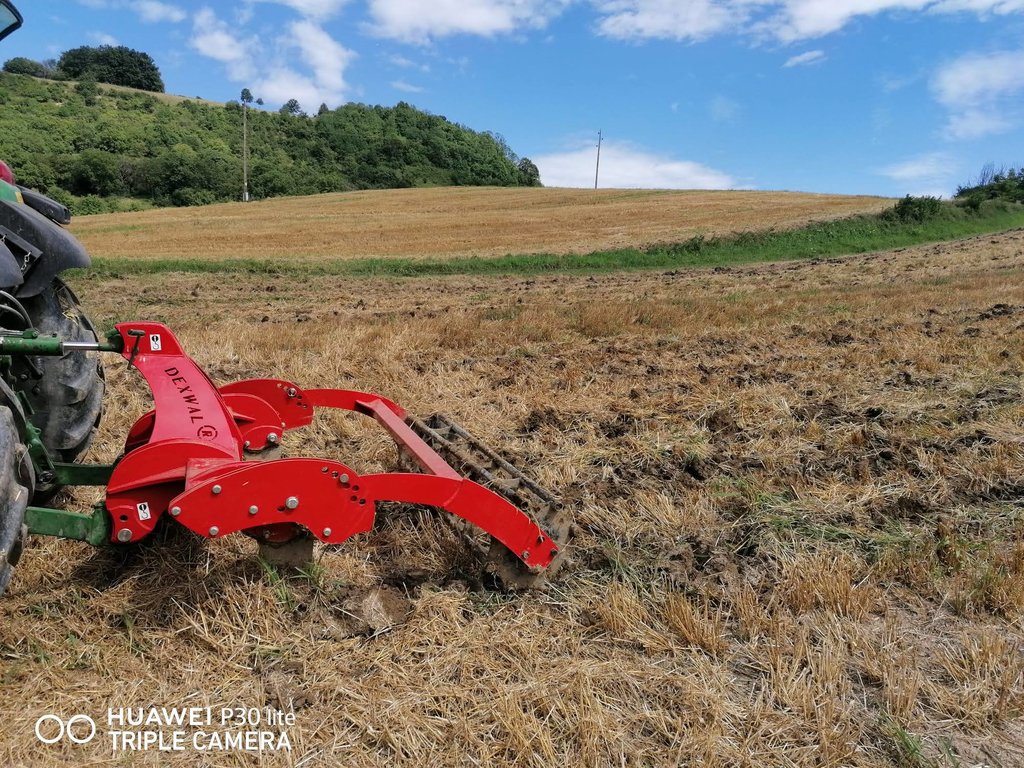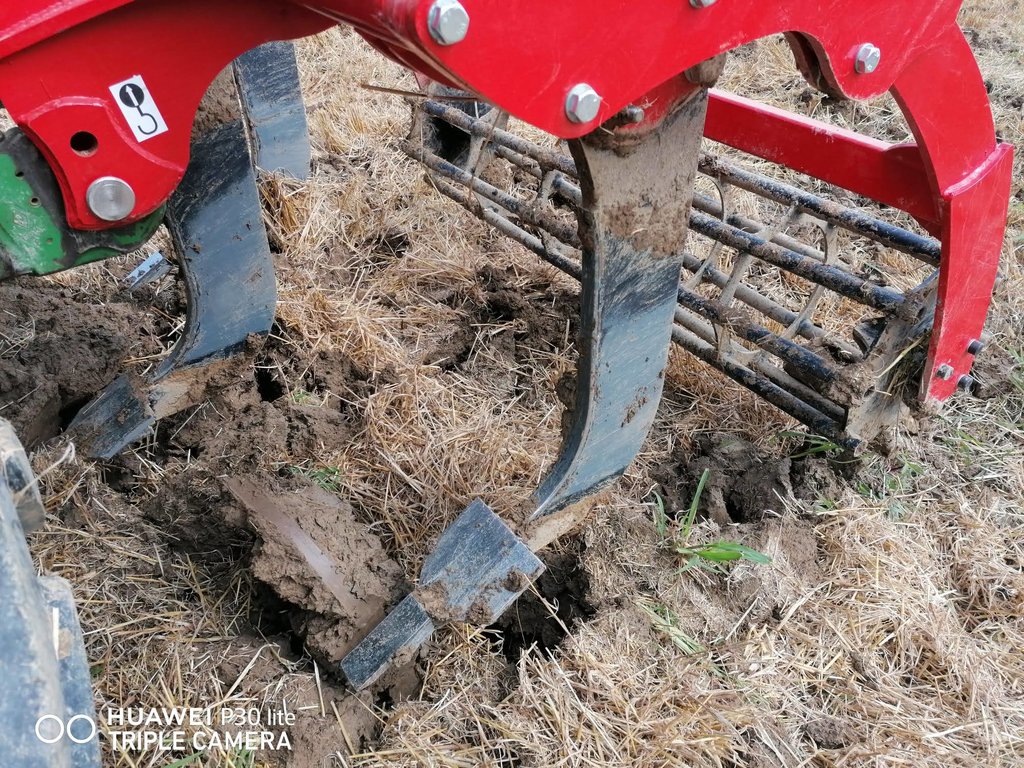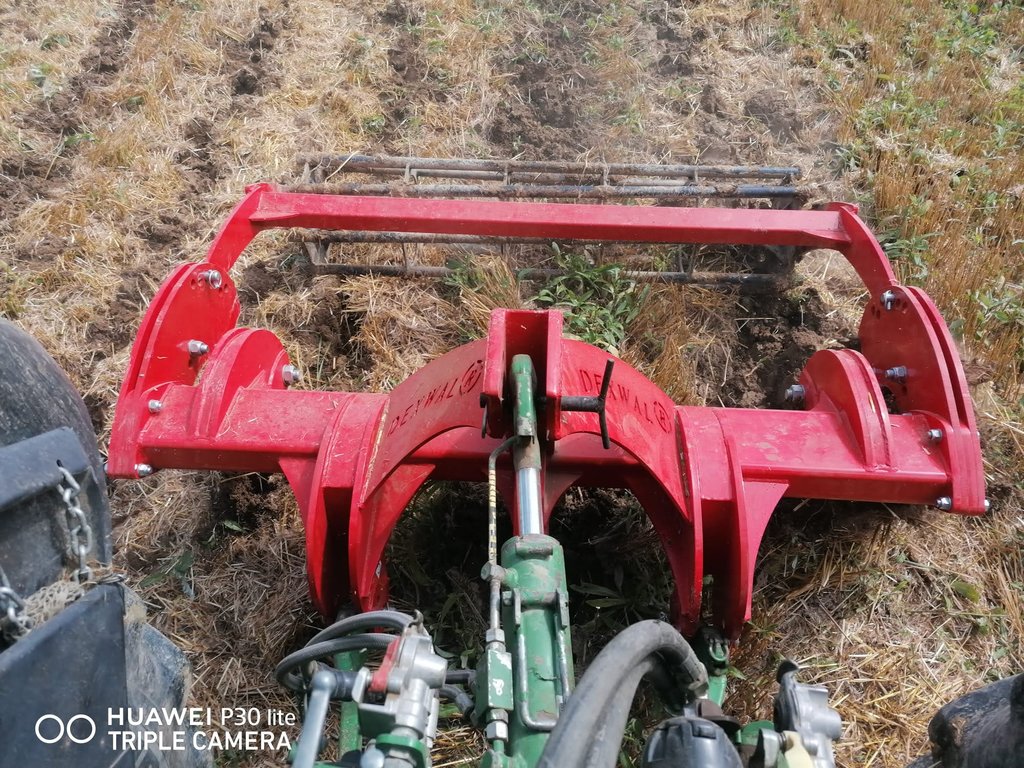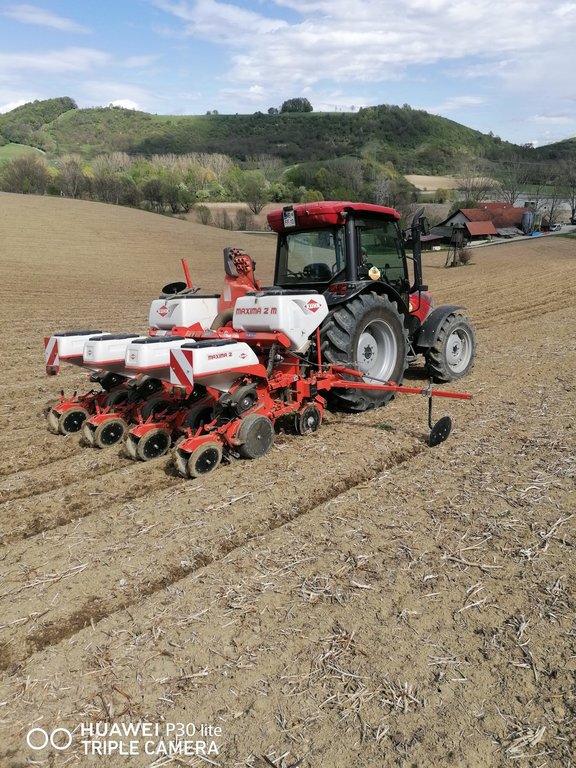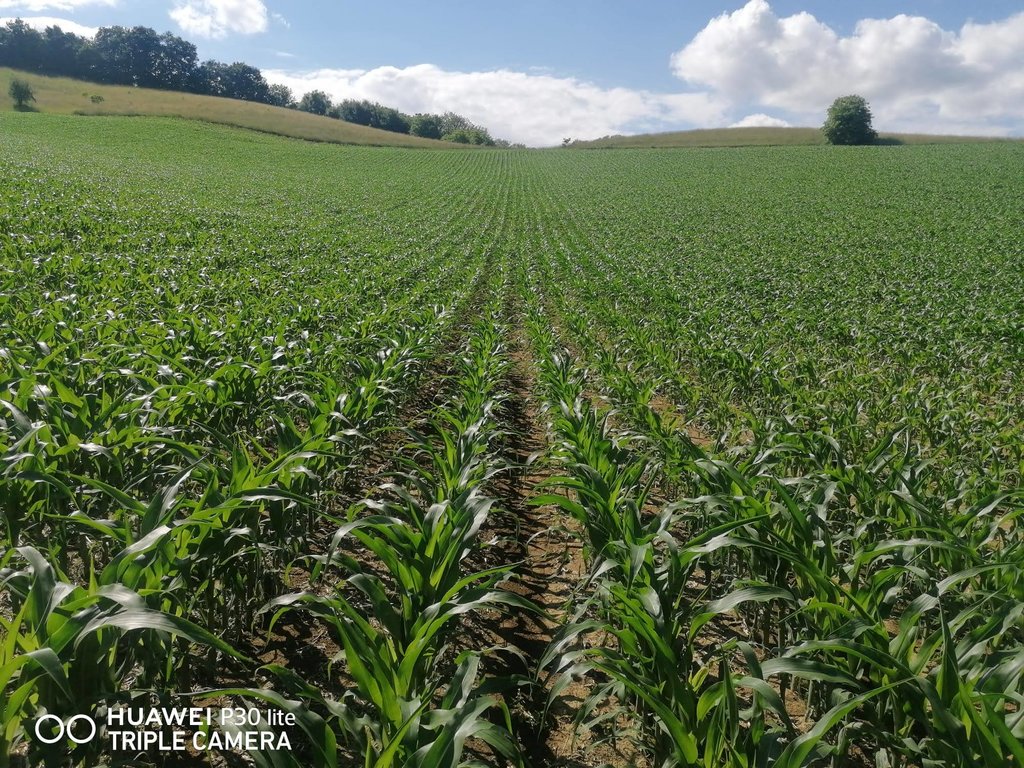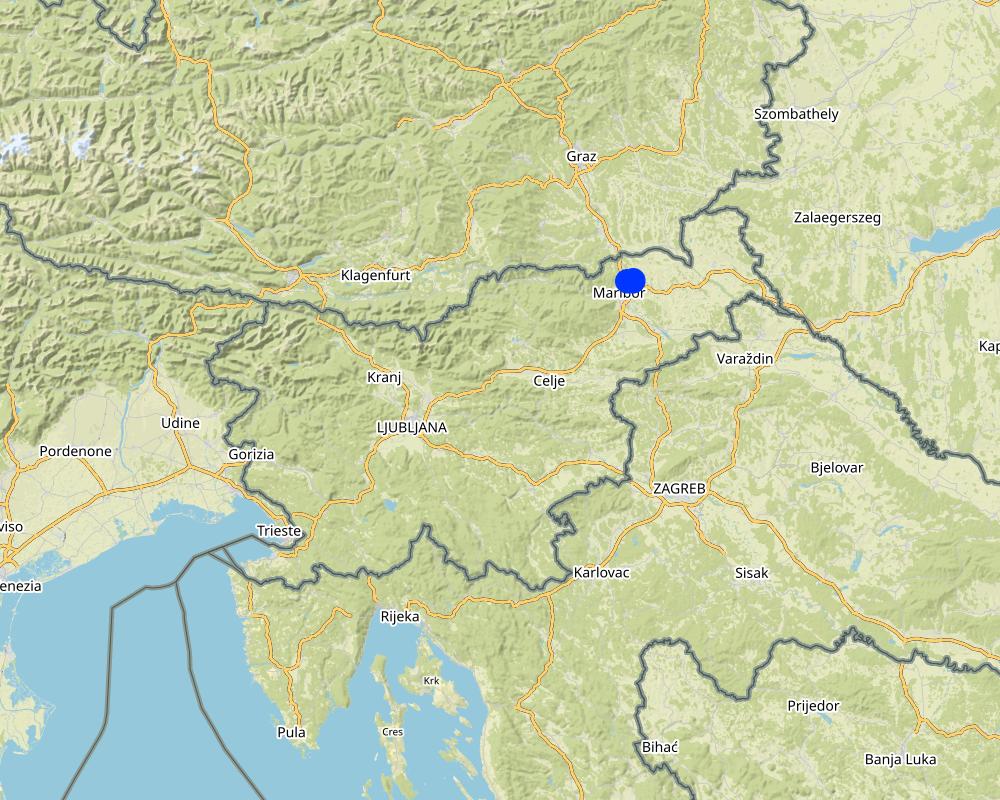Mulch-till [ប្រទេសស្លូវេនី]
- ការបង្កើត៖
- បច្ចុប្បន្នភាព
- អ្នកចងក្រង៖ Gregor Kramberger
- អ្នកកែសម្រួល៖ Matjaz Glavan
- អ្នកត្រួតពិនិត្យច្រើនទៀត៖ William Critchley, Rima Mekdaschi Studer
Konzervirajoča obdelava tal (mulch-till)
technologies_6241 - ប្រទេសស្លូវេនី
ពិនិត្យមើលគ្រប់ផ្នែក
ពង្រីកមើលទាំងអស់ បង្រួមទាំងអស់1. ព័ត៌មានទូទៅ
1.2 ព័ត៌មានលម្អិតពីបុគ្គលសំខាន់ៗ និងស្ថាប័នដែលចូលរួមក្នុងការវាយតម្លៃ និងចងក្រងឯកសារនៃបច្ចេកទេស
អ្នកជំនាញឯកទេស SLM:
អ្នកជំនាញឯកទេស SLM:
Curk Miha
Biotechnical Faculty, University of Ljubljana
ប្រទេសស្លូវេនី
អ្នកជំនាញឯកទេស SLM:
Cvejic Rozalija
Biotechnical Faculty, University of Ljubljana
ប្រទេសស្លូវេនី
អ្នកប្រើប្រាស់ដី:
Ropič Andrej
Farmer
ប្រទេសស្លូវេនី
ឈ្មោះគម្រោងដែលបានចងក្រងឯកសារ/ វាយតម្លៃលើបច្ចេកទេស (បើទាក់ទង)
OPtimal strategies to retAIN and re-use water and nutrients in small agricultural catchments across different soil-climatic regions in Europe (OPTAIN)ឈ្មោះអង្គភាពមួយ (ច្រើន) ដែលបានចងក្រងឯកសារ/ វាយតម្លៃបច្ចេកទេស (បើទាក់ទង)
Chamber of Agriculture and Forestry of Slovenia – Institute of Agriculture and Forestry Maribor (KGZS) - ប្រទេសស្លូវេនី1.3 លក្ខខណ្ឌទាក់ទងទៅនឹងការប្រើប្រាស់ទិន្នន័យដែលបានចងក្រងតាមរយៈ វ៉ូខេត
អ្នកចងក្រង និង(បុគ្គលសំខាន់ៗ)យល់ព្រមទទួលយកនូវលក្ខខណ្ឌនានាទាក់ទងទៅនឹងការប្រើប្រាស់ទិន្នន័យដែលបានចងក្រងតាមរយៈវ៉ូខេត:
បាទ/ចា៎
1.4 សេចក្តីប្រកាសស្តីពីចីរភាពនៃការពណ៌នាពីបច្ចេកទេស
តើបច្ចេកទេសដែលបានពណ៌នានេះមានបញ្ហាដែលផ្តោតលើការធ្លាក់ចុះគុណភាពដី, បើដូច្នេះវាមិនអាចត្រូវបានប្រកាសថាជាបច្ចេកទេសនៃការគ្រប់គ្រងប្រកបដោយចីរភាពទេ?
ទេ
2. ការពណ៌នាពីបច្ចេកទេស SLM
2.1 ការពណ៌នាដោយសង្ខេបពីបច្ចេកទេស
និយមន័យបច្ចេកទេស:
Mulch-till is a method of farming that does not utilise a plough, and thus the soil is not turned over. Furthermore, at least 30% of the cultivated area remains covered with organic residues left over from the previous crop. There are multiple benefits to the soil and carbon dioxide emissions are reduced.
2.2 ការពណ៌នាលម្អិតពីបច្ចេកទេស
ការពណ៌នា:
Mulch-till (also called “conservation agriculture” or “minimum tillage”) is a method of land management with modified, less intensive tillage, where land is covered with plant residues year-round (at least 30% cover) or grass, energy consumption is reduced, and there is less trampling/ compaction of the soil because of fewer machine passes and the protected surface. Under mulch-till, special agricultural machinery and attachments are required. Disc harrows and chisel ploughs are used to loosen the soil, and direct drills are employed for seeding. Ploughs are not used and the soil is not inverted. This method of tillage is intended to maintain soil structure, build up humus, improve nutrient supply and soil moisture, increase soil microbiological activity and also to prevent soil erosion. Mulch-till reduces the number of work operations on the cultivated area. Because the soil is disturbed less, this minimises the exposure of soil organic matter to the air, and therefore decreases the formation and release of CO2 to the atmosphere.
The debate over whether ploughing is still necessary has been going on for quite some time. Both mulch-till and ploughing have their advantages as well as disadvantages. Research shows that mulch-till reduces soil erosion and compaction, and this has a significant impact on soil fertility. On the other hand, ploughing better inhibits the spread of weeds and certain types of diseases and pests.
Mulch-till requires complete replacement of machines/tools, and this is a considerable initial investment. Regular annual maintenance of the equipment is needed also. Mulch-till provides full benefits after a number of years, through making sure that minimal soil inversion and organic soil coverage is guaranteed. It also requires good planning of crop rotation, the use of a special seed drill and employment of herbicides after emergence (or surface hoeing). Users mention one advantage being the low costs for tillage, which is less expensive than ploughing, and the reduction of soil erosion on sloping terrain. However, they do not like the high investment for equipment, possible lost of yields and increase in weeds: all tend to arise at the beginning of implementation. Knowledge and experience are required, as the technology is quite demanding, so there are chances of failure.
2.3 រូបភាពនៃបច្ចេកទេស
កំណត់សម្គាល់ទូទៅនៃរូបថត/រូភាព:
Mulch tillage technique and sowing of maize at the Ropič farm.
2.5 ប្រទេស/តំបន់/ទីតាំងកន្លែង ដែលបច្ចេកទេសត្រូវបានអនុវត្ត និងបានគ្រប់ដណ្តប់ដោយការវាយតម្លៃនេះ
ប្រទេស:
ប្រទេសស្លូវេនី
តំបន់/រដ្ឋ/ខេត្ត:
Jareninski dol, Pernica
បញ្ជាក់បន្ថែមពីលក្ខណៈនៃទីតាំង:
Vosek
បញ្ជាក់ពីការសាយភាយនៃបច្ចេកទេស:
- ត្រូវបានផ្សព្វផ្សាយត្រឹមតំបន់មួយ
ប្រសិនបើមិនច្បាស់ពីទំហំផ្ទៃដី សូមធ្វើការប៉ាន់ប្រម៉ាណ:
- < 0.1 គម2 (10 ហិកតា)
តើបច្ចេកទេស (មួយ ឬច្រើន) ទាំងនោះស្ថិតនៅក្នុងតំបន់ការពារជាអចិន្ត្រៃយ៍ណាមួយដែរឬទេ?
ទេ
Map
×2.6 កាលបរិច្ឆេទនៃការអនុវត្ត
បង្ហាញឆ្នាំនៃការចុះអនុវត្ត:
2020
2.7 ការណែនាំពីបច្ចេកទេស
សូមបញ្ជាក់តើបច្ចេកទេសត្រូវបានណែនាំឱ្យអនុវត្តដោយរបៀបណា:
- តាមរយៈការបង្កើតថ្មីរបស់អ្នកប្រើប្រាស់ដី
- ពេលកំពុងពិសោធន៍
មតិយោបល់ (ប្រភេទនៃគម្រោង ។ល។):
A few years ago, the farmer transitioned from traditional plowing to a mulch-tillage technique and has been using this method since 2020. In 2021, the farmer sought assistance from a consulting service to connect with the Biotechnical faculty in Ljubljana. Tests were conducted to assess the impact of conservation tillage. Following the positive results, the farmer has continued collaborating with the Biotechnical faculty and the public advisory service, further experimenting with the technology and maintaining the new cultivation approach. Today, he is one of the prominent advocates of conservation tillage.
3. ចំណាត់ថ្នាក់នៃបច្ចេកទេស SLM
3.1 គោលបំណងចម្បង (១ ឬច្រើន) នៃបច្ចេកទេសនេះ
- កាត់បន្ថយ, បង្ការ, ស្តារឡើងវិញនូវការធ្លាក់ចុះគុណភាពដី
- ការពារតំបន់ទីជម្រាល/តំបន់ខ្សែទឹកខាងក្រោមបញ្ចូលជាមួយបច្ចេកទេសផ្សេងទៀត
- កាត់បន្ថយហានិភ័យនៃគ្រោះមហន្តរាយ
- បន្ស៊ាំទៅនឹងការប្រែប្រួលអាកាសធាតុ/គ្រោះមហន្តរាយ និងផលប៉ះពាល់របស់វា
- កាត់បន្ថយការប្រែប្រួលអាកាសធាតុ និងផលប៉ះពាល់របស់វា
3.2 ប្រភេទដីប្រើប្រាស់មួយប្រភេទ (ច្រើនប្រភេទ) ដែលបានអនុវត្តបច្ចេកទេស
ដីប្រើប្រាស់ចម្រុះនៅលើដីតែមួយ:
ទេ

ដីដាំដំណាំ
- ដំណាំប្រចាំឆ្នាំ
ដំណាំប្រចាំឆ្នាំ - បញ្ជាក់ប្រភេទដំណាំ:
- ធញ្ញជាតិ - ស្រូវ
- ធញ្ញជាតិ - ពោត
- ធញ្ញជាតិ - ស្រូវសាលី (សិសិររដូវរងារ)
- ដំណាំចំណីសត្វ - ចន្ទល់ភ្នំ
- ដំណាំចំណីសត្វ - ផ្សេងៗ
- ពពួកសណ្តែក - ផ្សេងៗ
- ពពួកសណ្តែក - សណ្តែកសៀង
ចំនួនសារដែលដាំដំណាំក្នុងមួយឆ្នាំ:
- 1
តើជាការអនុវត្តន៍ដំណាំចន្លោះ?
ទេ
តើជាការអនុវត្តន៍ដំណាំវិលជុំ?
បាទ/ចា៎
បើបាទ/ច៎ា សូមបញ្ជាក់:
Continuously 1 main crop: maize, wheat (winter) or barely (winter) and fodder peas or soy. After the main crop, the rotation includes cover crops (greening) which consist of mixtures of plants such as phacelia, clover, mung bean, etc.
3.3 បន្ទាប់ពីអនុវត្តបច្ចេកទេស តើដីប្រើប្រាស់មានការប្រែប្រួលដែររឺទេ?
បន្ទាប់ពីអនុវត្តបច្ចេកទេស តើដីប្រើប្រាស់មានការប្រែប្រួលដែររឺទេ?
- ទេ (បន្តទៅសំណួរ 3.4)
3.4 ការផ្គត់ផ្គង់ទឹក
ការផ្គត់ផ្គង់ទឹកនៅកន្លែងអនុវត្តបច្ចេកទេស:
- ទឹកភ្លៀង
3.5 ក្រុម SLM ដែលបច្ចេកទេសស្ថិតនៅក្នុង
- ធ្វើឱ្យប្រសើរឡើងគម្របដី/ ដំណាំគម្របដី
- កាត់បន្ថយការរំខានដល់ដី
- ការគ្រប់គ្រងជីជាតិដីតាមបែបចម្រុះ
3.6 វិធានការ SLM ដែលបញ្ចូលនូវបច្ចេកទេស

វិធានការក្សេត្រសាស្ត្រ
- A1: ដំណាំ/គម្របដី
- A2: សារធាតុសរីរាង្គ/ជីជាតិដី
- A3: ការរក្សាស្រទាប់ដីខាងលើ
- A6: ការគ្រប់គ្រងកាកសំណល់
A3: ប្រព័ន្ធភ្ជួររាស់ខុសៗគ្នា:
A 3.2: Reduced tillage (> 30% soil cover)
A6: បញ្ជាក់ពីការគ្រប់គ្រងកាកសំណល់:
A 6.4: រក្សាទុក
3.7 កំណត់ប្រភេទនៃការធ្លាក់ចុះគុណភាពដីសំខាន់ៗដែលបច្ចេកទេសនេះបានដោះស្រាយ

ការហូរច្រោះដីដោយសារទឹក
- Wt: ការបាត់ដីស្រទាប់លើដោយការហូរច្រោះ
- Wg: ការកកើតឡើងនូវកំទេចកំទីដីស្រទាប់ក្រោម

ការធ្លាក់ចុះសារធាតុគីមីក្នុងដី
- Cn: ការថយចុះជីជាតិ និងកាត់បន្ថយបរិមាណសារធាតុសរីរាង្គ (មិនកើតឡើងដោយការហូរច្រោះទេ)

ការបាត់បង់រូបសាស្ត្រនៃដី
- Pc: ការហាប់ណែន

ការធ្លាក់ចុះជីវសាស្ត្រនៃដី
- Bc: ការថយចុះនូវគម្របរុក្ខជាតិ
- Bq: ការថយចុះនូវជីវម៉ាស/ បរិមាណ
- Bl: ការបាត់បង់មីក្រូ និងម៉ាក្រូសរីរាង្គរបស់ដី
3.8 ការពារ កាត់បន្ថយ ឬស្តារឡើងវិញនៃការធ្លាក់ចុះគុណភាពដី
បញ្ជាក់ពីគោលដៅរបស់បច្ចេកទេស ដែលផ្តោតទៅការធ្លាក់ចុះគុណភាពដី:
- ការការពារការធ្លាក់ចុះគុណភាពដី
- ការកាត់បន្ថយការធ្លាក់ចុះគុណភាពដី
4. បច្ចេកទេសជាក់លាក់ សកម្មភាពអនុវត្ត ធាតុចូល និងថ្លៃដើម
4.1 គំនូសបច្ចេកទេសនៃបច្ចេកទេសនេះ
លក្ខណៈពិសេសនៃបច្ចេកទេស (ទាក់ទងនឺងគំនូរបច្ចេកទេស):
Whether it is low-till or conventional tillage depends on the tool use during soil tillage and how we use it. There are many implementation variants of conservation tillage that go by different professional names and definitions. Low-till is defined according to the depth of tillage, the intensity of soil layer mixing, the coverage of soil surface with harvest (organic) residues or intermediate tillage residues, according to the way tools move on the soil and the number of machine operations that are performed individually or combined (basic tillage, soil loosening seedbed preparation, pre-sowing tillage, sowing, ...). We focus on one version of low-till that we estimate has the greatest chances of being established in a short time in the case study area, which is so called »mulch-till«. We will concentrate on the term »mulch-till« which we define as a medium deep (10 cm) conservation tillage technique using chisel plow in combination with disk harrow. The coverage of the soil surface with residues must be at least 30% or higher. In addition, a special seeder is required to carry out "mulch" sowing (with moving parts). The success of mulch-till also depends on the combination with other implemented measures like crop rotation, cover crops, etc.
ឈ្មោះអ្នកនិពន្ធ:
Bodenbear beitung und Bestellung
កាលបរិច្ឆេទ:
2015
4.2 ព័ត៌មានទូទៅដែលពាក់ព័ន្ធនឹងការគណនាធាតុចូល និងថ្លៃដើម
កំណត់របៀបនៃការគណនាថ្លៃដើម និងធាតុចូល:
- ក្នុងតំបន់អនុវត្តបច្ចេកទេស
កំណត់ទំហំ និងឯកត្តាផ្ទៃដី:
1 ha
បើសិនប្រើឯកតាតាមតំបន់ សូមបញ្ជាក់តម្លៃបម្លែងវាទៅជាហិកតា (ឧ. 1 ហិកតា = 2.47 អា)៖ 1 ហិកតា =:
1 ha = 10,000 m2
ផ្សេងៗ/ រូបិយប័ណ្ណជាតិ (បញ្ជាក់):
EUR
បើពាក់ព័ន្ធសូមកំណត់អត្រាប្តូរប្រាក់ពីដុល្លាទៅរូបិយប័ណ្ណតំបន់ (ឧ. 1 ដុល្លារ = 79.9 រៀលនៃរូបិយប័ណ្ណប្រេស៊ីល) ៖ 1 ដុល្លារ =:
0,97
កំណត់ថ្លៃឈ្នួលជាមធ្យមនៃការជួលកម្លាំងពលកម្មក្នុងមួយថ្ងៃ:
90.90
4.3 សកម្មភាពបង្កើត
| សកម្មភាព | រយៈពេល (រដូវកាល) | |
|---|---|---|
| 1. | Purchase of 2-row disc harrow | 1st year |
| 2. | Purchase deep chisel plow | 1st year |
| 3. | Purchase pneumatic seed drill combined with rotary harrow | 1st year |
| 4. | Purchase pneumatic precision planter with rotating elements | 1st year |
| 5. | Purchase cover crop seed drill | 1st year |
មតិយោបល់:
Tractor should also be considered as part of the investment in implementing the mulch-till technology. The required tractor for operating Mulch-till is at least 110 HP. Let's assume a tractor with four-wheel drive, 95–125 kW (129–170 HP), with an investment cost of 66,400 €. Its usage should be economically justified for the entire farm (used for all farm tasks).
4.4 ថ្លៃដើម និងធាតុចូលដែលត្រូវការសម្រាប់ការបង្កើតបច្ចេកទេស
| បញ្ជាក់ពីធាតុចូល | ឯកតា | បរិមាណ | ថ្លៃដើមក្នុងមួយឯកតា | ថ្លៃធាតុចូលសរុប | % នៃថ្លៃដើមដែលចំណាយដោយអ្នកប្រើប្រាស់ដី | |
|---|---|---|---|---|---|---|
| សម្ភារៈ | Purchase of 2-row disc harrow | piece | 29,7 | 404,0404 | 12000,0 | 100,0 |
| សម្ភារៈ | Purchase deep chisel plow | piece | 29,7 | 101,0101 | 3000,0 | 100,0 |
| សម្ភារៈ | Pneumatic seed drill combined with rotary harrow | piece | 29,7 | 909,0909 | 27000,0 | 100,0 |
| សម្ភារៈ | Pneumatic precision planter with rotating elements | piece | 29,7 | 572,3905 | 17000,0 | 100,0 |
| សម្ភារៈ | Cover crop seed drill | piece | 29,7 | 151,5151 | 4500,0 | 100,0 |
| ថ្លៃដើមសរុបក្នុងការបង្កើតបច្ចេកទេស | 63500,0 | |||||
| ថ្លៃដើមសរុបក្នុងការបង្កើតបច្ចេកទេសគិតជាដុល្លារ | 65463,92 | |||||
មតិយោបល់:
The estimated lifespan of the equipment represents only an illustrative measure in terms of total hours, hectares, or machine work until its obsolescence. This data is not considered in the cost calculation. It is generally not economically viable to use a machine until its complete obsolescence, as it may become technologically outdated or require excessive investment for restoration compared to its economic usage. It is more sensible to use the machine's depreciation period. The average depreciation value is determined based on the average annual usage of the machine. The depreciation period for attachments is 12 years.
4.5 សកម្មភាពថែទាំ
| សកម្មភាព | ពេលវេលា/ ភាពញឹកញាប់ | |
|---|---|---|
| 1. | Tractor operation and maintanance | It is used for all operations related to the technology (without cover crop seed drill operation).. |
| 2. | Deep chisel plow operation and maintanance | 1 time per 5 years, on all cultivated field surfaces (29,7 ha), 1.0 h/ha. |
| 3. | 2-row disc harrow operation and maintanance | 2 time per year, on all cultivated field surfaces (29,7 ha), 0.8 h/ha. |
| 4. | Pneumatic precision planter with rotating elements operation and maintanance | 1 times per year, on 50 % of all cultivated field surfaces (14.85 ha), 1.3 h/ha. |
| 5. | Cover crop seed drill operation and maintanance | 1 time per year, on all cultivated field surfaces (29,7 ha), 0.8 h/ha (combined with harrow). |
| 6. | Pneumatic seed drill combined with rotary harrow operation and maintanance | 1 times per year, on 50 % of all cultivated field surfaces (14,85 ha), 1.4 h/ha. |
| 7. | Purchase cover crop seed mixture Fruh | 1 time per year, on all cultivated field surfaces (29,7 ha). |
4.6 កំណត់ថ្លៃដើមសម្រាប់ការថែទាំ/ សកម្មភាពរបស់បច្ចេកទេស (ក្នុងរយៈពេលមួយឆ្នាំ)
| បញ្ជាក់ពីធាតុចូល | ឯកតា | បរិមាណ | ថ្លៃដើមក្នុងមួយឯកតា | ថ្លៃធាតុចូលសរុប | % នៃថ្លៃដើមដែលចំណាយដោយអ្នកប្រើប្រាស់ដី | |
|---|---|---|---|---|---|---|
| កម្លាំងពលកម្ម | Tractor operation | EUR/ha | 29,7 | 18,144 | 538,88 | 100,0 |
| កម្លាំងពលកម្ម | Machine maintenance | EUR/ha | 29,7 | 2,88 | 85,54 | 100,0 |
| សម្ភារៈ | Machine avarage total costs of tractor operation and maintanance | EUR/ha | 29,7 | 122,598 | 3641,16 | 100,0 |
| សម្ភារៈ | Machine avarage total costs of deep chisel plow operation and maintanance | EUR/ha | 29,7 | 4,36 | 129,49 | 100,0 |
| សម្ភារៈ | Machine avarage total costs of 2-row disc harrow operation and maintanance | EUR/ha | 29,7 | 30,432 | 903,83 | 100,0 |
| សម្ភារៈ | Machine avarage total costs of pneumatic precision planter with rotating elements operation and maintanance | EUR/ha | 14,85 | 29,744 | 441,7 | 100,0 |
| សម្ភារៈ | Machine avarage total costs of cover crop seed drill operation and maintanance | EUR/ha | 29,7 | 2,872 | 85,3 | 100,0 |
| សម្ភារៈ | Machine avarage total costs of Pneumatic seed drill combined with rotary harrow operation and maintanance | EUR/ha | 14,85 | 52,416 | 778,38 | 100,0 |
| សម្ភារៈដាំដុះ | Cover crop mixture Fruh | EUR/ha | 29,7 | 66,768 | 1983,01 | 100,0 |
| ថ្លៃដើមសរុបសម្រាប់ការថែទាំដំណាំតាមបច្ចេកទេស | 8587,29 | |||||
| ថ្លៃដើមសរុបសម្រាប់ការថែទាំដំណាំតាមបច្ចេកទេសគិតជាដុល្លារ | 8852,88 | |||||
4.7 កត្តាសំខាន់បំផុតដែលមានឥទ្ធិពលដល់ការចំណាយ
ពណ៌នាពីកត្តាប៉ះពាល់ចម្បងៗទៅលើថ្លៃដើម:
It very much depends on the type of soil, what is the structure of the soil. In addition, the planning of the crop rotation and cover crops also affect the costs. As a result, weed development and subsequent herbicide use may be different.
5. លក្ខណៈបរិស្ថានធម្មជាតិ និងមនុស្ស
5.1 អាកាសធាតុ
បរិមាណទឹកភ្លៀងប្រចាំឆ្នាំ
- < 250 មម
- 251-500 មម
- 501-750 មម
- 751-1,000 មម
- 1,001-1,500 មម
- 1,501-2,000 មម
- 2,001-3,000 មម
- 3,001-4,000 មម
- > 4,000 មម
កំណត់បរិមាណទឹកភ្លៀង (បើដឹង) ជា មីលីម៉ែត្រ:
1015,00
លក្ខណៈពិសេស/ មតិយោបល់លើរដូវភ្លៀង:
The most precipitation falls in summer, the months with the highest average precipitation are June and August, the least precipitation falls in winter, in January and February at least, and in principle more precipitation falls in autumn than in spring.
បញ្ជាក់ឈ្មោះឯកសារយោងនៃស្ថានីយឧតុនិយម:
Jareninski vrh (1981 – 2010)
តំបន់កសិអាកាសធាតុ
- មានភ្លៀងមធ្យម
Mean annual temperature in year 2014 Jareninski vrh is 11,9°C.
5.2 សណ្ឋានដី
ជម្រាលជាមធ្យម:
- រាបស្មើ (0-2%)
- ជម្រាលតិចតួច (3-5%)
- មធ្យម (6-10%)
- ជម្រាលខ្ពស់បន្តិច (11-15%)
- ទីទួល (16-30%)
- ទីទួលចោត (31-60%)
- ទីទួលចោតខ្លាំង (>60%)
ទម្រង់ដី:
- ខ្ពង់រាប
- កំពូលភ្នំ
- ជម្រាលភ្នំ
- ជម្រាលទួល
- ជម្រាលជើងភ្នំ
- បាតជ្រលងភ្នំ
តំបន់តាមរយៈកម្ពស់ :
- 0-100 ម
- 101-500 ម
- 501-1,000 ម
- 1,001-1,500 ម
- 1,501-2,000 ម
- 2,001-2,500 ម
- 2,501-3,000 ម
- 3,001-4,000 ម
- > 4,000 ម
បញ្ជាក់ថាតើបច្ចេកទេសនេះត្រូវបានអនុវត្តន៍នៅក្នុង:
- សណ្ឋានដីផត
មតិយោបល់ និងបញ្ចាក់បន្ថែមអំពីសណ្ឋានដី :
There are depressions, settlements are in the valley, concave type.
5.3 ដី
ជម្រៅដីជាមធ្យម:
- រាក់ខ្លាំង (0-20 សម)
- រាក់ (21-50 សម)
- មធ្យម (51-80 សម)
- ជ្រៅ (81-120 សម)
- ជ្រៅខ្លាំង (> 120 សម)
វាយនភាពដី (ស្រទាប់លើ):
- មធ្យម (ល្បាយ, ល្បាប់)
វាយនភាពដី (> 20 សម ស្រទាប់ក្នុង):
- មធ្យម (ល្បាយ, ល្បាប់)
សារធាតុសរីរាង្គនៅស្រទាប់ដីខាងលើ:
- មធ្យម (1-3%)
5.4 ទឹកដែលអាចទាញមកប្រើប្រាស់បាន និងគុណភាពទឹក
នីវ៉ូទឹកក្រោមដី:
5-50 ម
ទឹកលើដីដែលអាចទាញយកប្រើប្រាស់បាន:
ល្អ
គុណភាពទឹក (មិនបានធ្វើប្រត្តិកម្ម):
ទឹកសម្រាប់តែការធ្វើកសិកម្ម (ស្រោចស្រព)
គុណភាពទឹក គឺផ្តោតទៅលើ៖:
ទឹកលើផ្ទៃដី
តើមានបញ្ហាភាពទឹកប្រៃហូរចូលមកដែរឬទេ?
ទេ
តើទឹកជំនន់កំពុងកើតមាននៅតំបន់នេះដែររឺទេ?
បាទ/ចា៎
ភាពទៀងទាត់:
ម្តងម្កាល
មតិយោបល់ និងលក្ខណៈពិសេសផ្សេងៗទៀតលើគុណភាព និងបរិមាណទឹក :
Hydromelioration was carried out in the area, a drainage system and water retention systems (e.g. ponds and basins) were arranged.
5.5 ជីវៈចម្រុះ
ភាពសម្បូរបែបនៃប្រភេទ:
- កម្រិតមធ្យម
ភាពសម្បូរបែបនៃទីជម្រក:
- កម្រិតមធ្យម
5.6 លក្ខណៈនៃអ្នកប្រើប្រាស់ដីដែលអនុវត្តបច្ចេកទេស
នៅមួយកន្លែង ឬពនេចរ :
- នៅមួយកន្លែង
ទីផ្សារនៃប្រព័ន្ធផលិតកម្ម:
- ពាណិជ្ជកម្ម/ ទីផ្សារ
ចំណូលក្រៅកសិកម្ម:
- 10-50% នៃចំណូល
កម្រិតជីវភាព:
- មធ្យម
ឯកជន ឬក្រុម:
- ធ្វើខ្លួនឯង/ គ្រួសារ
កម្រិតប្រើប្រាស់គ្រឿងយន្ត:
- គ្រឿងយន្ត/ ម៉ាស៊ីន
យេនឌ័រ:
- បុរស
អាយុរបស់អ្នកប្រើប្រាស់ដី:
- វ័យកណ្តាល
5.7 ទំហំផ្ទៃដីជាមធ្យមនៃដីប្រើប្រាស់ដោយអ្នកប្រើប្រាស់ដី ក្នុងការអនុវត្តបច្ចេកទេស
- < 0.5 ហិកតា
- 0.5-1 ហិកតា
- 1-2 ហិកតា
- 2-5 ហិកតា
- 5-15 ហិកតា
- 15-50 ហិកតា
- 50-100 ហិកតា
- 100-500 ហិកតា
- 500-1,000 ហិកតា
- 1,000-10,000 ហិកតា
- > 10,000 ហិកតា
តើផ្ទៃដីនេះចាត់ទុកជាទំហំកម្រិតណាដែរ ខ្នាតតូច មធ្យម ឬខ្នាតធំ (ធៀបនឹងបរិបទតំបន់)?
- ខ្នាតមធ្យម
5.8 ភាពជាម្ចាស់ដី កម្មសិទ្ធប្រើប្រាស់ដី និងកម្មសិទ្ធប្រើប្រាស់ទឹក
ភាពជាម្ចាស់ដី:
- ឯកជន មានកម្មសិទ្ធ
កម្មសិទ្ធិប្រើប្រាស់ដី:
- កិច្ចសន្យាជួល
- ឯកជន
កម្មសិទ្ធប្រើប្រាស់ទឹក:
- ជាក្រុម (មានដែនកំណត់)
តើកម្មសិទ្ធប្រើប្រាស់ដី គឺផ្អែកលើប្រព័ន្ធច្បាប់បែបបុរាណ?
ទេ
សូមបញ្ជាក់:
based on national legal system
5.9 ការប្រើប្រាស់សេវាកម្ម និងហេដ្ឋារចនាសម្ព័ន្ធ
សុខភាព:
- មិនល្អ
- មធ្យម
- ល្អ
ការអប់រំ:
- មិនល្អ
- មធ្យម
- ល្អ
ជំនួយបច្ចេកទេស:
- មិនល្អ
- មធ្យម
- ល្អ
ការងារ (ឧ. ការងារក្រៅកសិដ្ឋាន):
- មិនល្អ
- មធ្យម
- ល្អ
ទីផ្សារ:
- មិនល្អ
- មធ្យម
- ល្អ
ថាមពល:
- មិនល្អ
- មធ្យម
- ល្អ
ផ្លូវ និងការដឹកជញ្ជូន:
- មិនល្អ
- មធ្យម
- ល្អ
ទឹកផឹក និងអនាម័យ:
- មិនល្អ
- មធ្យម
- ល្អ
សេវាកម្មហិរញ្ញវត្ថុ:
- មិនល្អ
- មធ្យម
- ល្អ
6. ផលប៉ះពាល់ និងការសន្និដ្ឋាន
6.1 ផលប៉ះពាល់ក្នុងបរិវេណអនុវត្តបច្ចេកទេសដែលកើតមាន
ផលប៉ះពាល់លើសេដ្ឋកិច្ចសង្គម
ផលិតផល
ផលិតកម្មដំណាំ
មតិយោបល់/ ការបញ្ជាក់:
Some farmers report a slight drop in yield in first years after the implementation of the measure, but the farmer in the case study location didn't notice any difference in yield.
ហានិភ័យនៃភាពបរាជ័យរបស់ផលិតកម្ម
មតិយោបល់/ ការបញ្ជាក់:
Reduced risk, but with the wrong approach it can increase. For example, reduced risk due to unfavorable weather conditions, increased risk due to the possibility of weed development.
ការគ្រប់គ្រងដី
មតិយោបល់/ ការបញ្ជាក់:
Simplified soil tillage technology.
ចំណូល និងថ្លៃដើម
ការចំណាយលើធាតុចូលកសិកម្ម
មតិយោបល់/ ការបញ្ជាក់:
Reduced costs due to lower energy (fuel) consumption.
បន្ទុកការងារ
មតិយោបល់/ ការបញ្ជាក់:
Fewer hours dedicated for tillage.
ផលប៉ះពាល់ទៅលើវប្បធម៌សង្គម
សន្តិសុខស្បៀង/ ភាពគ្រប់គ្រាន់ខ្លួនឯង
មតិយោបល់/ ការបញ្ជាក់:
Facilitated production with lower costs, motivation to do business in agriculture.
ចំណេះដឹង SLM / ការធ្លាក់ចុះគុណភាពដី
មតិយោបល់/ ការបញ្ជាក់:
With positive effects more interest of the farmer in sustainable production.
ផលប៉ះពាល់ទៅលើអេកូឡូស៊ី
វដ្តទឹក/លំហូរ
លំហូរទឹកលើផ្ទៃដី
រំហួត
ដី
សំណើមដី
គម្របដី
ការបាត់បង់ដី
ការកើនឡើងដី
ដីប្រេះ
ដីហាប់
វដ្តនៃសារធាតុចិញ្ចឹម/ការទទួលបាន
សារធាតុសរីរាង្គដី/ការបូនក្រោមដី
ជីវចម្រុះ៖ ដំណាំ, សត្វ
ដំណាំគម្រប
ជីវម៉ាស/ កាបូនលើដី
ភាពសម្បូរបែបនៃរុក្ខជាតិ
ប្រភេទរាតត្បាត
ភាពសម្បូរបែបនៃសត្វ
មតិយោបល់/ ការបញ្ជាក់:
Cover crops act as hiding places for various animals.
ប្រភេទសត្វមានប្រយោជន៍
មតិយោបល់/ ការបញ្ជាក់:
Plants attract pollinators.
ភាពសម្បូរបែបនៃទីជំរក
ការកាត់បន្ថយហានិភ័យនៃគ្រោះមហន្តរាយ និងគ្រោះអាកាសធាតុ
ផលប៉ះពាល់នៃគ្រោះរាំងស្ងួត
ការបំភាយនៃកាបូន និងឧស្ម័នផ្ទះកញ្ចក់
6.2 ផលប៉ះពាល់ក្រៅបរិវេណអនុវត្តបច្ចេកទេសដែលកើតមាន
Buffering/សមត្ថភាពចម្រោះ
មតិយោបល់/ ការបញ្ជាក់:
Surface cover with plants.
ខូចខាតដល់ហេដ្ឋារចនាសម្ព័ន្ធសាធារណៈ/ឯកជន
មតិយោបល់/ ការបញ្ជាក់:
The soil is not carried into ditches and ponds.
6.3 ភាពប្រឈម និងភាពរួសនៃបច្ចេកទេសទៅនឹងការប្រែប្រួលអាកាសធាតុ និងគ្រោះអាកាសធាតុ/ គ្រោះមហន្តរាយ (ដែលដឹងដោយអ្នកប្រើប្រាស់ដី)
ការប្រែប្រួលអាកាសធាតុ
ការប្រែប្រួលអាកាសធាតុ
| រដូវកាល | កើនឡើង ឬថយចុះ | លក្ខណៈឆ្លើយតបនៃបច្ចេកទេសទៅនឹងការប្រែប្រួលអាកាសធាតុ | |
|---|---|---|---|
| បរិមាណទឹកភ្លៀងប្រចាំឆ្នាំ | ថយចុះ | ល្អ |
គ្រោះអាកាសធាតុ (មហន្តរាយ)
គ្រោះមហន្តរាយធម្មជាតិ
| លក្ខណៈឆ្លើយតបនៃបច្ចេកទេសទៅនឹងការប្រែប្រួលអាកាសធាតុ | |
|---|---|
| ព្យុះភ្លៀងតាមតំបន់ | ល្អណាស់ |
គ្រោះមហន្តរាយអាកាសធាតុ
| លក្ខណៈឆ្លើយតបនៃបច្ចេកទេសទៅនឹងការប្រែប្រួលអាកាសធាតុ | |
|---|---|
| រលកកម្តៅ | ល្អ |
| រាំងស្ងួត | ល្អ |
គ្រោះមហន្តរាយទឹក
| លក្ខណៈឆ្លើយតបនៃបច្ចេកទេសទៅនឹងការប្រែប្រួលអាកាសធាតុ | |
|---|---|
| ដីបាក់ | ល្អណាស់ |
6.4 ការវិភាគថ្លៃដើម និងអត្ថប្រយោជន៍
តើផលចំណេញ និងថ្លៃដើមត្រូវបានប្រៀបធៀបគ្នាយ៉ាងដូចម្តេច (ទស្សនៈរបស់អ្នកប្រើប្រាស់ដី)?
រយៈពេលខ្លី:
អវិជ្ជមានតិចតួច
រយៈពេលវែង:
វិជ្ជមាន
តើផលចំណេញ និងការថែទាំ/ ជួសជុលត្រូវបានប្រៀបធៀបគ្នាយ៉ាងដូចម្តេច (ទស្សនៈរបស់អ្នកប្រើប្រាស់ដី)?
រយៈពេលខ្លី:
វិជ្ជមាន
រយៈពេលវែង:
វិជ្ជមាន
មតិយោបល់:
The initial establishment and investment costs for implementing the technology are high, and in the short term, the benefits may not be very noticeable or even negative compared to conservative technology. However, the long-term benefits are more significant and positive. While there are recurring costs involved, such as maintenance expenses, they are considerably lower compared to the initial investment costs. The technology requires substantial upfront investment in equipment, which can initially outweigh the immediate returns. It takes time for the technology to mature and for the full benefits to be realized. As the system becomes established and optimized, the positive outcomes become more apparent over the long run. Additionally, the lower costs mentioned refer to the ongoing maintenance and operational expenses required to sustain the technology (machines), which are generally lower than the initial investment costs. These costs are often outweighed by the benefits gained from improved efficiency, reduced resource consumption, and other long-term advantages. Therefore, while the short-term returns may not be overwhelmingly positive, the investment in the technology pays off over time, with greater benefits and lower operational costs.
6.5 ការទទួលយកបច្ចេកទេស
- 1-10%
ក្នុងចំណោមគ្រួសារទាំងអស់ដែលបានអនុវត្តបច្ចេកទេស តើមានប៉ុន្មានគ្រួសារដែលចង់ធ្វើដោយខ្លួនឯង ដោយមិនទទួលបានសម្ភារៈលើកទឹកចិត្ត/ប្រាក់ឧបត្ថម្ភ?:
- 91-100%
6.6 ការបន្សុំា
តើថ្មីៗនេះ បច្ចេកទេសនេះត្រូវបានកែតម្រូវដើម្បីបន្ស៊ាំទៅនឹងស្ថានភាពប្រែប្រួលដែរឬទេ?
បាទ/ចា៎
ផ្សេងៗ (សូមបញ្ជាក់):
added equipment/mechanization attachments to facilitate technology implementation, improved technology implementation with knowledge and experience
បញ្ជាក់ពីការបន្ស៊ាំនៃបច្ចេកទេស (ការរៀបចំ, ឧបករណ៍/ប្រភេទ ។ល។):
Added cover crop seed drill. more emphasis on cover crop.
6.7 ភាពខ្លាំង/ គុណសម្បត្តិ/ ឱកាសនៃបច្ចេកទេស
| ភាពខ្លាំង/ គុណសម្បត្តិ/ ឱកាសនៅកន្លែងរបស់អ្នកប្រើប្រាស់ដី |
|---|
| Less depression, erosion and soil leaching. |
| Cost and time (fewer passes, machine hours, less machine power required). |
| Care for nature, sustain natural resources. |
| ភាពខ្លាំង/ គុណសម្បត្តិ/ ឱកាស ទស្សនៈរបស់បុគ្គលសំខាន់ៗ |
|---|
| In the long term it enables the achievement of better soil conditions, in terms of appropriate ratios of water, air, nutrients, organic matter, microbial activity, pH, microbial activity, pH and other factors of soil fertility. |
| Compaction and drying of the top layer of the soil is significantly less frequent and as a result losses of young plants are therefore smaller. |
| It reduces the potential for soil erosion. A major threat to soil fertility is erosion processes (wind, water and other erosion), where the most fertile surface layers of the soil are carried away to other parts of the ecosystem that are not intended for food production. |
| It brings advantages in terms of energy consumption and the possibility of carrying out production tasks in a shorter time and in difficult weather conditions. Conservation tillage tools typically operate in a shallower soil layer and mix less soil mass, it enables the use of tools with larger working widths and thus less unproductive driving in the field. |
| Benefits in terms of reduced transfer of phytopharmaceuticals and nutrients excess from the cultivation area to water and other ecosystems. |
| Reduced tillage improves soil quality, reduces nutrient leaching and lowers greenhouse gas emissions. |
| Benefits in terms of bioavailability and nutrient uptake efficiency. |
| Benefits in terms of greater adaptability of crops to extreme weather events. |
| Benefits in terms of maintaining the overall biological diversity of the agricultural landscape and soil. |
6.8 ភាពខ្សោយ/ គុណវិបត្តិ/ ហានិភ័យនៃបច្ចេកទេស និងវិធីសាស្ត្រដោះស្រាយ
| ភាពខ្សោយ/ គុណវិបត្តិ/ ហានិភ័យ ទស្សនៈរបស់អ្នកប្រើប្រាស់ដី | តើបច្ចេកទេសទាំងនោះបានដោះស្រាយបញ្ហាដូចម្តេច? |
|---|---|
| A big investment in machinery. | It is possible to start gradually with cheaper and simpler machines (also home-made). |
| Adaptation of crop protection. | Implementing integrated pest management (IPM). |
| ភាពខ្សោយ/ គុណវិបត្តិ/ ហានិភ័យ ទស្សនៈរបស់អ្នកចងក្រងឬបុគ្គលសំខាន់ៗ | តើបច្ចេកទេសទាំងនោះបានដោះស្រាយបញ្ហាដូចម្តេច? |
|---|---|
| An increase in the occurrence of certain types of weeds and a high dependence on certain types of herbicides. Some studies show that the introduction of conservation tillage slightly increases losses from certain diseases and pests. | For successful weed control, it is important to have a varied crop rotation, frequent sowing of cover crops and intercrops, and that the weeds never leave uncontrolled development on the stubble. The variegated crop rotation is meant as an obstacle that interrupts the development cycle of diseases and pests. How we handle harvest residues is also important. The more finely they are chopped by combines, mulchers or tools for vertical tillage before sowing, the faster they decompose and the worse the chances of harmful organisms developing on them. An evenly distributed mulch of harvest residues should remain, which prevents the emergence of new waves of weeds. These additional measures, together with mechanical weed control with new types of tools, allow limiting the weed population to a level that can be controlled with a limited range of herbicides. |
| Investment costs in machines designed for the method of soil cultivation can be very high. An important obstacle in the introduction of conservation tillage is the large investments in new machinery... The value of purchasing these tools can well exceed the amount of 100,000 euros for an individual farm, which is a practically unfeasible investment for small farms. | Small farms can take the transition to conservation farming only with the help of hired machinery services from neighbouring large farms that have been able to invest in new equipment. The subsidization of the purchase of machinery and also the economic legal status of the farm in terms of VAT calculation play an important role. |
| It is necessary to replace all the tools used by farmers according to the old methods of tillage. It is necessary to purchase adapted cultivators, harrows, looseners and especially seeder drills. | Increase in the supply of relatively inexpensive machines from manufacturers from Eastern Europe and Turkey, which can increase the availability of this equipment to smaller farms. |
| In the first years of the transition period, there may be a significant reduction in yields and poor financial results. There is a yield reduction and financial stress during the transition period to the new system. The transition from conventional cultivation to conservation tillage is usually difficult and risky. | Growers must be financially strong in order to make the transition, and the areas under alternative cultivation systems must increase gradually when they really master the new cultivation technique. Good financial support during the transition period is very important for small farms with weak investment assets. Targeted education and training is necessary, as technological errors due to lack of knowledge regarding the implementation of conservation cultivation in different soil types can be economically very fatal. |
| A small increase in the seeding rate (10 to 15 %) is often recommended to compensate for losses caused by diseases and pests at the time of plant emergence. | A necessary cost that must be accepted (higher sowing rate for the main crops and additional crops – cover crops) for the successful implementation of the measure. |
7. ឯកសារយោង និងវេបសាយ
7.1 វិធីសាស្ត្រ/ ប្រភពនៃព័ត៌មាន
- ការសម្ភាសន៍ជាមួយអ្នកប្រើប្រាស់ដី
1 farmer (Andrej Ropič)
- ការសម្ភាសន៍ជាមួយអ្នកជំនាញ/ ឯកទេស
3 (Biotechnical Faculty; Matjaž Glavan, Miha Curk, and Rozalija Cvejič)
- ការចងក្រងពីរបាកការណ៍ និងឯកសារផ្សេងៗទៀតដែលមាន
2 (we utilized the following documents: "ANALYSIS OF ECONOMIC EFFICIENCY OF ALTERNATIVE AGRONOMIC PRACTICE (AAP) ON VVO" by Črtomir Rozman, Karmen Pažek, Mario Lešnik, and "Bodenbearbeitung und Bestellung Definition von Bodenbearbeitungs- und Bestellsystemen" (translated to English as "Tillage and cultivation Definition of tillage and cultivation systems") by Dr. Joachim Bischoff et al.)
តើពេលណាដែលទិន្នន័យបានចងក្រង (នៅទីវាល)?
17/01/2023
មតិយោបល់:
Visit to the farm and farmer interview. A working group was established, where we met 2 times to review and respond to the questionnaire.
7.2 ឯកសារយោងដែលបានចេញផ្សាយ
ចំណងជើង អ្នកនិពន្ធ ឆ្នាំ ISBN:
TJ Townsend, SJ Ramsden, P Wilson. Analysing reduced tillage practices within a bio-economic modelling framework. Agricultural Systems 146 (2016) 91–102.
មានប្រភពមកពីណា? ថ្លៃដើមប៉ុន្មាន?
ScienceDirect
ចំណងជើង អ្នកនិពន្ធ ឆ្នាំ ISBN:
E Houshyar, MJ SheikhDavoodi, M Almassi, H Bahrami, H Azadi, M Omidi, G Sayyad, F Witlox. Silage corn production in conventional and conservation tillage systems. Part I: Sustainability analysis using combination of GIS/AHP and multi-fuzzy modeling. Ecological Indicators 39 (2014) 102–114.
មានប្រភពមកពីណា? ថ្លៃដើមប៉ុន្មាន?
ScienceDirect
7.3 ការភ្ជាប់ទៅកាន់ព័ត៌មានពាក់ព័ន្ធលើប្រព័ន្ធអនឡាញ
ចំណងជើង/ ពណ៌នា:
C Rozman, K Pažek, M Lešnik. Analiza ekonomske ucinkovitosti alternativne agronomske prakse (AAP) na VVO. Univerza v Mariboru, Fakulteta za kmetijstvo in biosistemske vede, 2018.
វេបសាយ:
https://www.google.com/url?sa=t&rct=j&q=&esrc=s&source=web&cd=&ved=2ahUKEwjNtpH7peD8AhWFzaQKHdPXBM4QFnoECAYQAQ&url=https%3A%2F%2Fwww.kgzs-ms.si%2Fwp-content%2Fuploads%2F2018%2F07%2FD.T3.3.1-Study-final-May-2018.pdf&usg=AOvVaw3qni6nXmwUM25mhI0FwPln
ចំណងជើង/ ពណ៌នា:
Mimalna obdelava tal – praktični primeri na naših kmetijah (žipo, ropic, horvat)
វេបសាយ:
https://www.google.com/url?sa=t&rct=j&q=&esrc=s&source=web&cd=&cad=rja&uact=8&ved=2ahUKEwiZ6smRpuD8AhWrsaQKHcRSBoMQFnoECAkQAQ&url=https%3A%2F%2Fwww.kmetijski-zavod.si%2FPortals%2F0%2Flombergarjevi%2FMinimalna%2520obdelava%2520tal%2520%25E2%2580%2593%2520prakti%25C4%258Dni%2520primeri%2520na%2520na%25C5%25A1ih%2520kmetijah%2520%5BSamodejno%2520shranjeno%5D.pdf%3Fver%3D2021-12-13-094249-623&usg=AOvVaw1jtWGuL4ovgrvC0rvqm1iS
ការតភ្ជាប់ និងម៉ូឌុល
ពង្រីកមើលទាំងអស់ បង្រួមទាំងអស់ការតភ្ជាប់
គ្មានការតភ្ជាប់
ម៉ូឌុល
គ្មានម៉ូឌុល


